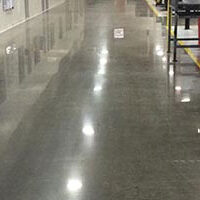
How to Polish Concrete Floors Properly
The right process makes all the difference!
If you’ve decided that polished concrete flooring is the best choice for your meeting place, retail space or industrial facility, the next step is to find a reliable team to do the polishing work. (If you’re not aware of the many benefits of polishing concrete, including increasing the durability and longevity of your floors, see our overview of polished concrete.)
While you may find DIY guides out there or may even be able to rent a machine, you’ll get the better results from a team of experts who know what they’re doing and have the professional equipment and manpower to do a thorough polishing job.
The importance of a trustworthy concrete polishing contractor
Unfortunately, we see some people in our industry selling “concrete polishing” services that are actually not the real deal—they’ll only do one or two steps, then put a clear sealer on to make the floor appear glossier than it actually is.
The sealer typically wears off within six months to a year, and the underlying floor lacks not only the luster of a truly polished floor, but doesn’t have the hardness or cleanliness of real polished concrete, either.
Contractors who do only a partial method often don’t disclose that that’s what they are doing, so it’s important to be familiar with the real polishing process.
What a true concrete polishing job looks like
A real concrete polishing job involves 10 or so stages. It is a mechanical process in which the floor is smoothed using a professional grinding machine. Each stage uses a different coarseness of grind (ranging from 30- to 30,000-grit surfaces, some of which incorporate diamonds) in order to get the level of smoothness and gloss desired.
There are two primary methods for polishing concrete, each with different advantages
The dry polish method
Dry polishing is ideal for getting a high-gloss shine for your concrete floor. It generally uses large, corded electrical machines to polish the floor, but smaller hand machines can be used for harder-to-reach areas. Despite its name, some water is put down between stages to keep the dust down.
You can watch the dry polish method in this time-lapse video of our crews treating a church lobby floor. What for the change in the floor glossiness after each step:
The Wet Polish Method
The wet polishing method uses water during every stage of the concrete polishing method. It creates a low-luster surface and can only be applied to large, open areas.
Advantages of the wet polish method are that it requires less downtime and offers some cost savings. Because of the amount of water used, it’s a virtually dust-free process that avoids dust contamination of the area.
Learn more about wet vs. dry concrete polishing.
Looking for a reliable concrete polishing contractor in the Southeast?
Do you think concrete polishing might be the right choice for your facility? If you’re located in the Carolinas, northern Georgia, or eastern Tennessee, CPC Floor Coatings can take a look at your facility and provide you with a free estimate.
We have a 40-year history in the floor industry, and our flooring crews have the experience and manpower to get jobs completed on time and within your budget.
Give CPC Floor Coatings a call at (864) 855-0600 or contact us online.


